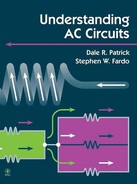Preface
Understanding AC Circuits is an introductory text that provides coverage of the various topics in the field of alternating current (ac) electronics. The key concepts in this book are discussed through a simplified approach that greatly enhances learning. The use of mathematics is discussed through applications and illustrations.
Every unit is organized in a step-by-step progression of concepts and theory. Each unit begins with an introduction and unit objectives. A discussion of important concepts and theories follows. A self-examination, with answers provided, is integrated into each chapter to reinforce learning. Experimental activities, with components and equipment listed, are included in each unit to help students learn electronics through practical experimental applications. The final learning activity for each unit is a unit examination, which includes at least twenty objective, multiple-choice questions.
Definitions of important terms are presented at the beginning of each unit. Several appendices are used to aid students in performing experimental activities. The expense of the equipment needed for the experiments is kept to a minimum. A comprehensive parts list is provided, as is information on electronics distributors. The experiments suggested are low-cost activities that can be performed in the home or a school laboratory. They are very easy to understand and emphasize troubleshooting concepts. Electronics can be learned experimentally at low cost by means of completion of these lab activities. Appendices dealing with electronics symbols and soldering are provided for easy reference.
This book covers alternating current (ac) circuits, an important foundation in the study of electronics. The companion text is Understanding DC Circuits. Both of these books are organized in the same easy-to-understand format. They can be used to acquire a basic understanding of electronics in the home, school, or workplace. The sequence of the books allows the student to progress at a desired pace in the study of electronics basics and to perform experiments with low-cost equipment and supplies (depending on availability). As students progress, they may wish to purchase various types of test equipment at varying degrees of expense. The experiments allow the students to further develop an understanding of the topics discussed in each unit. They are intended as an important supplement to student learning.
The following supplemental materials are available to provide an aid to effective learning:
1. Instructor's Resource Manual—answers to all unit examinations and suggested data for experimental activities, including a comprehensive analysis of each experiment.
2. Instructor's Transparency Masters—enlarged reproductions of selected illustrations in the textbook that are suitable for use for transparency preparation for class presentations.
3. Instructor's Test Item File—suggested objective, multiple-choice questions for use with each unit of instruction.
These supplements are extremely valuable for instructors in organizing electronics classes. The complete instructional cycle, from objectives to evaluation, is included in this series of books. We hope you will find this book easy to understand and that you are successful in your pursuit of knowledge in an exciting technical area. Electronics is an extremely vast and interesting field of study. Understanding AC Circuits provides a foundation for understanding electronics technology.
